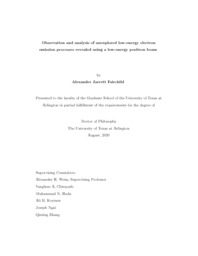
ATTENTION: The works hosted here are being migrated to a new repository that will consolidate resources, improve discoverability, and better show UTA's research impact on the global community. We will update authors as the migration progresses. Please see MavMatrix for more information.
Show simple item record
| dc.contributor.advisor | Weiss, Alex H | |
| dc.creator | Fairchild, Alexander Jarrett | |
| dc.date.accessioned | 2022-01-20T18:09:31Z | |
| dc.date.available | 2022-01-20T18:09:31Z | |
| dc.date.created | 2020-08 | |
| dc.date.issued | 2020-08-17 | |
| dc.date.submitted | August 2020 | |
| dc.identifier.uri | http://hdl.handle.net/10106/30170 | |
| dc.description.abstract | This dissertation presents measurements of the kinetic energy distributions of low-energy, positron-induced electrons emitted from single-layer of graphene (SLG), highly oriented pyrolytic graphite (HOPG), Si, Cu and TiO2 surfaces. The electron kinetic energies were measured using UTA’s 1m flight path ToF spectrometer attached to a variable energy positron beam. The unique capability of this system to transport extremely low-energy positrons (∼1 eV) to the sample surface while simultaneously measuring the energies of outgoing electrons with high collection efficiencies down to 0 eV has made possible the measurement of the full, background-free spectra of electrons emitted as a result of annihilation-induced Auger transitions. These capabilities have enabled the measurements presented here, which provide an unambiguous identification of the hitherto unexplored LVV Auger transition in oxygen and the first direct observation of an Auger process occurring entirely within the valence band of SLG. The TiO2 O LVV and SLG VVV line shapes have been theoretically investigated using a first principals-based model which incorporates the distribution of annihilation-induced holes, the self-convolution of the valence band density of states (DOS), and estimates of the electron escape probabilities. These results have important implications for the understanding of Auger-stimulated ion desorption, Coulombic decay, photodynamic cancer therapies, and may yield important insights into the radiation-induced reactive sites for corrosion and catalysis. Numerical simulations of the ToF spectrometer have made possible the direct comparison between the measured and calculated line shapes and have allowed the characterization of the system’s transport efficiency, timing resolution, and energy resolution for the set of low-energy transport settings used in this work. Lastly, measurements of the kinetic energy distributions of electrons emitted as a result of Auger-mediated positron sticking (AMPS) at the surfaces of Cu, HOPG, SLG, and Si are presented and analyzed. First principles based modeling of the AMPS line shape provides an estimate of the positron surface state binding energy and suggests that a more detailed analysis may provide the basis for a novel, top-layer selective positron-induced electron spectroscopy. | |
| dc.format.mimetype | application/pdf | |
| dc.language.iso | en_US | |
| dc.subject | PAES | |
| dc.subject | AMPS | |
| dc.subject | O LVV | |
| dc.subject | VVV | |
| dc.title | Observation and analysis of unexplored low-energy electron emission processes revealed using a low-energy positron beam | |
| dc.type | Thesis | |
| dc.degree.department | Physics | |
| dc.degree.name | Doctor of Philosophy in Physics and Applied Physics | |
| dc.date.updated | 2022-01-20T18:09:31Z | |
| thesis.degree.department | Physics | |
| thesis.degree.grantor | The University of Texas at Arlington | |
| thesis.degree.level | Doctoral | |
| thesis.degree.name | Doctor of Philosophy in Physics and Applied Physics | |
| dc.type.material | text | |
| dc.creator.orcid | 0000-0003-4748-5175 | |
Files in this item
- Name:
- FAIRCHILD-DISSERTATION-2020.pdf
- Size:
- 5.225Mb
- Format:
- PDF
This item appears in the following Collection(s)
Show simple item record


